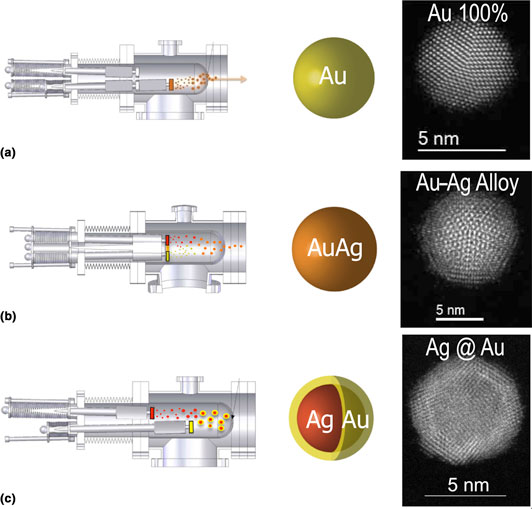Crossref Citations
This article has been cited by the following publications. This list is generated based on data provided by
Crossref.
Nikitin, Daniil
Hanuš, Jan
Ali‐Ogly, Suren
Polonskyi, Oleksandr
Drewes, Jonas
Faupel, Franz
Biederman, Hynek
and
Choukourov, Andrei
2019.
The evolution of Ag nanoparticles inside a gas aggregation cluster source.
Plasma Processes and Polymers,
Vol. 16,
Issue. 10,
Nelli, Diana
Krishnadas, Anjana
Ferrando, Riccardo
and
Minnai, Chloé
2020.
One-Step Growth of Core–Shell (PtPd)@Pt and (PtPd)@Pd Nanoparticles in the Gas Phase.
The Journal of Physical Chemistry C,
Vol. 124,
Issue. 26,
p.
14338.
Libenská, Hana
Hanuš, Jan
Košutová, Tereza
Dopita, Milan
Kylián, Ondřej
Cieslar, Miroslav
Choukourov, Andrei
and
Biederman, Hynek
2020.
Plasma‐based synthesis of iron carbide nanoparticles.
Plasma Processes and Polymers,
Vol. 17,
Issue. 11,
Popok, Vladimir N.
and
Kylián, Ondřej
2020.
Gas-Phase Synthesis of Functional Nanomaterials.
Applied Nano,
Vol. 1,
Issue. 1,
p.
25.
Shelemin, Artem
Pleskunov, Pavel
Kousal, Jaroslav
Drewes, Jonas
Hanuš, Jan
Ali‐Ogly, Suren
Nikitin, Daniil
Solař, Pavel
Kratochvíl, Jiří
Vaidulych, Mykhailo
Schwartzkopf, Matthias
Kylián, Ondřej
Polonskyi, Oleksandr
Strunskus, Thomas
Faupel, Franz
Roth, Stephan V.
Biederman, Hynek
and
Choukourov, Andrei
2020.
Nucleation and Growth of Magnetron‐Sputtered Ag Nanoparticles as Witnessed by Time‐Resolved Small Angle X‐Ray Scattering.
Particle & Particle Systems Characterization,
Vol. 37,
Issue. 2,
Zhao, Junlei
Mayoral, Alvaro
Martínez, Lidia
Johansson, Mikael P.
Djurabekova, Flyura
and
Huttel, Yves
2020.
Core–Satellite Gold Nanoparticle Complexes Grown by Inert Gas-Phase Condensation.
The Journal of Physical Chemistry C,
Vol. 124,
Issue. 44,
p.
24441.
Liu, Jinming
He, Shi-Hai
and
Wang, Jian-Ping
2020.
High-Yield Gas-Phase Condensation Synthesis of Nanoparticles to Enable a Wide Array of Applications.
ACS Applied Nano Materials,
Vol. 3,
Issue. 8,
p.
7942.
Liu, Jinming
Wu, Kai
He, Shihai
Bai, Jianmin
Xu, Yun-Hao
and
Wang, Jian-Ping
2021.
Large Superparamagnetic FeCo Nanocubes for Magnetic Theranostics.
ACS Applied Nano Materials,
Vol. 4,
Issue. 9,
p.
9382.
Nelli, Diana
Roncaglia, Cesare
Ahearn, Samuel
Di Vece, Marcel
Ferrando, Riccardo
and
Minnai, Chloé
2021.
Octahedral Growth of PtPd Nanocrystals.
Catalysts,
Vol. 11,
Issue. 6,
p.
718.
Drewes, Jonas
Vahl, Alexander
Carstens, Niko
Strunskus, Thomas
Polonskyi, Oleksandr
and
Faupel, Franz
2021.
Enhancing composition control of alloy nanoparticles from gas aggregation source by in operando optical emission spectroscopy.
Plasma Processes and Polymers,
Vol. 18,
Issue. 3,
Batková, Š.
Kozák, T.
Haviar, S.
Mareš, P.
and
Čapek, J.
2021.
Effect of exit-orifice diameter on Cu nanoparticles produced by gas-aggregation source.
Surface and Coatings Technology,
Vol. 417,
Issue. ,
p.
127196.
Nelli, Diana
Cerbelaud, Manuella
Ferrando, Riccardo
and
Minnai, Chloé
2021.
Tuning the coalescence degree in the growth of Pt–Pd nanoalloys.
Nanoscale Advances,
Vol. 3,
Issue. 3,
p.
836.
Ghildiyal, Pankaj
Biswas, Prithwish
Herrera, Steven
Mulholland, George W.
Yang, Yong
Abbaschian, Reza
and
Zachariah, Michael R.
2021.
Magnetic-Field Directed Vapor-Phase Assembly of Low Fractal Dimension Metal Nanostructures: Experiment and Theory.
The Journal of Physical Chemistry Letters,
Vol. 12,
Issue. 16,
p.
4085.
Corrêa, Leonardo M.
Moreira, Murilo
Rodrigues, Varlei
and
Ugarte, Daniel
2021.
Quantitative Structural Analysis of AuAg Nanoparticles Using a Pair Distribution Function Based on Precession Electron Diffraction: Implications for Catalysis.
ACS Applied Nano Materials,
Vol. 4,
Issue. 11,
p.
12541.
Tanner, Hugh
Hodgson, Lorna
Mantell, Judith
and
Verkade, Paul
2021.
Correlative Light and Electron Microscopy IV.
Vol. 162,
Issue. ,
p.
39.
Nikitin, Daniil
Hanuš, Jan
Pleskunov, Pavel
Krtouš, Zdeněk
Ali‐Ogly, Suren
Tafiichuk, Renata
Biliak, Kateryna
Protsak, Mariia
Valter, Jan
Vyskočil, Jiři
Choukourov, Andrei
and
Biederman, Hynek
2021.
Novel gas aggregation cluster source based on post magnetron.
Plasma Processes and Polymers,
Vol. 18,
Issue. 9,
Ali-Ogly, Suren
Kousal, Jaroslav
Nikitin, Daniil
Pleskunov, Pavel
Hanuš, Jan
Choukourov, Andrei
and
Biederman, Hynek
2022.
Computational fluid dynamics predicts the nanoparticle transport in gas aggregation cluster sources.
Journal of Physics D: Applied Physics,
Vol. 55,
Issue. 44,
p.
445203.
Isaac, N. A.
Pikaar, I.
and
Biskos, G.
2022.
Metal oxide semiconducting nanomaterials for air quality gas sensors: operating principles, performance, and synthesis techniques.
Microchimica Acta,
Vol. 189,
Issue. 5,
Wu, Kai
Liu, Jinming
Chugh, Vinit Kumar
Liang, Shuang
Saha, Renata
Krishna, Venkatramana D
Cheeran, Maxim C-J
and
Wang, Jian-Ping
2022.
Magnetic nanoparticles and magnetic particle spectroscopy-based bioassays: a 15 year recap.
Nano Futures,
Vol. 6,
Issue. 2,
p.
022001.
Popok, Vladimir N.
2022.
Formation and applications of polymer films with gas-phase aggregated nanoparticles: A brief review.
Thin Solid Films,
Vol. 756,
Issue. ,
p.
139359.




